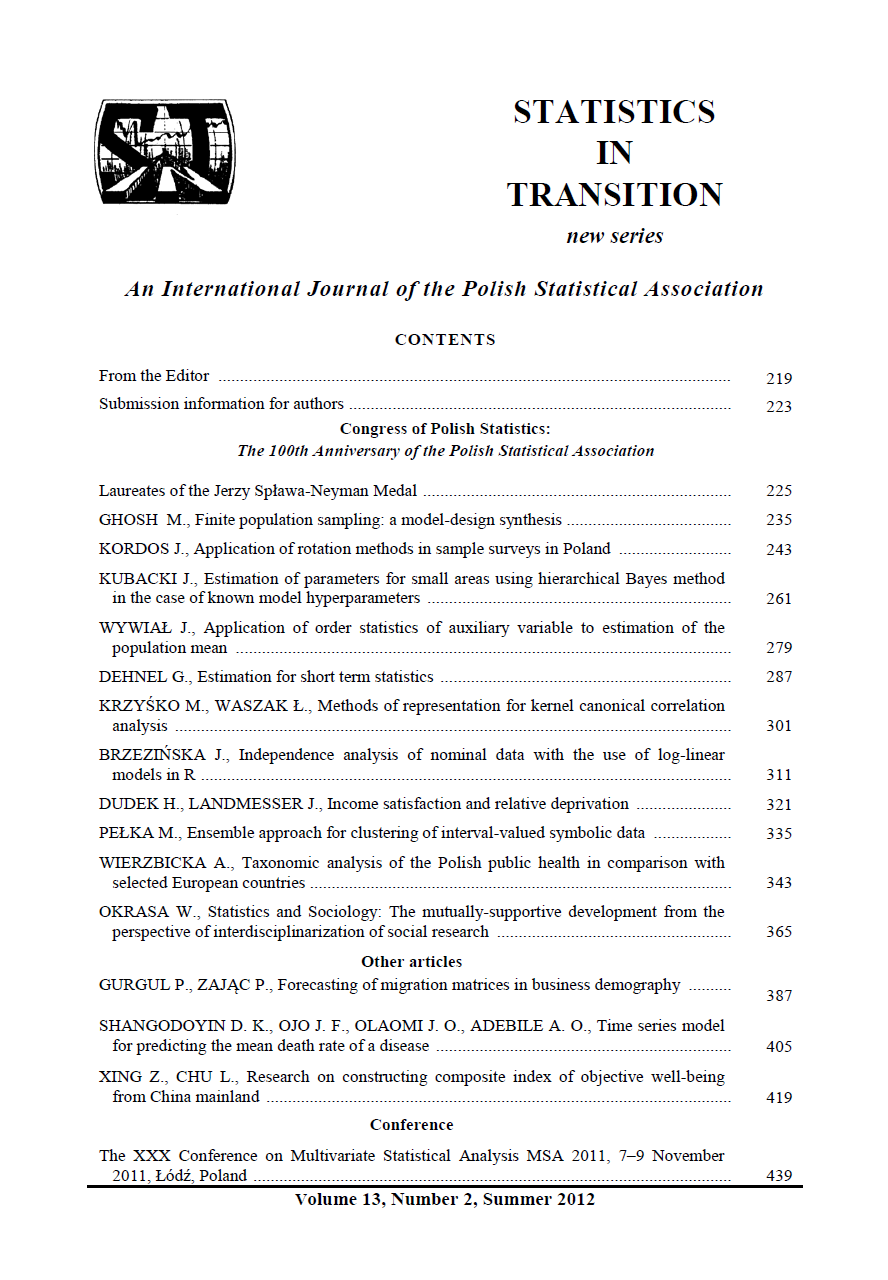ARTICLE
ABSTRACT
As an international organization the European Union pursues a range of purposes including improvement of public health, prevention of human illness and diseases as well as elimination of the sources of danger to physical and mental health. To enable effective health policies supporting actions of the member states, the data and materials which are fundamental to public health assessments are collected at the Community level. They underpin a variety of analyses necessary to evaluate changes in medical systems and determine the degree of similarity between the EU member states. This article analyses public health in Poland in relation to selected European countries. The study is based on the medical, economic and social indicators available from the EUROSTAT database. The taxonomic methods used in the study allowed ranking the sampled countries and identifying those with the highest level of public health. A more detailed assessment was based on the general presentation of health care systems in each country. In addition to Poland, the other post-socialist countries in the sample are Bulgaria, Estonia, Lithuania, Romania, Slovenia, Hungary and the Czech Republic. Importantly, the study covers the years 2004-2009, after most of the countries joined the European Union. The reason why other former Eastern bloc countries were omitted from the study was the unavailability of appropriate data in the EUROSTAT database. The paper discusses a group of developed European countries too. However, because the complicated historical past of the post-socialist countries and the socio-economic difficulties that result from it make their analysis more interesting from a comparative point of view, they are the primary group explored in this article. This article is divided into theoretical and empirical section. It begins with a short introduction. Part two presents the concept of health and public health. The third part describes key factors differentiating health systems. It briefly presents the main healthcare models, that is: the Bismarck’s, Beveridge’s, Siemaszko’s and the residual model. The fourth section refers to a grouping method based on Hellwig’s taxonomic measure of development. Part five with its scope includes a comparative analysis of public health status of selected European countries. The sixth part presents major determinants of cluster formation. The paper ends with a conclusion that summarizes the obtained results
KEYWORDS
Public health, taxonomic measure of development, comparative analysis
REFERENCES
ACHESON, D., 1998. Inequalities in health: report of an independent inquiry, London: HMSO.
BERBEKA, J., 2006. Poziom życia ludności a wzrost gospodarczy w krajach Unii Europejskiej [Standard of living and economic growth in the European Union], Akademia Ekonomiczna [Academy of Economics], Kraków (in Polish).
CAMPBELL, A., 1976. Subjective measures of well- being, American Psychologist.
CAMPBELL, A., CONVERSE, P., RODGERS, W., 1976. The quality of American life, Russel Sage Fundation, New York.
Constitution of the World Health Organization, 1948.
GETZEN, T. E., 2000. Ekonomika zdrowia [Health Economics], PWN [Polish Scientific Publishers PWN] , Warszawa (in Polish).
Glossary of Terms used in Health, 1984, WHO, Geneva.
GRABIŃSKI, T., WYDYMUS S., ZELIAŚ A., 1989. Metody taksonomii numerycznej w modelowaniu zjawisk społeczno-gospodarczych [Methods of numerical taxonomy in modeling of socio-economic phenomena], PWN [Polish Scientific Publishers PWN], Warszawa (in Polish).
Health Promotion Glossary, 1998. World Health Organization, Geneva.
HELLWIG, Z., 1968. Zastosowanie metody taksonomicznej do typologicznego podziału krajów ze względu na poziom rozwoju oraz zasoby i strukturę wykwalifikowanych kadr [Use of taxonomic method for the typological division of countries based on their level of development and the resources and structure of qualified personnel], Przegląd Statystyczny [Statistical Review] (in Polish).
HOSSMAN, I., KARSCH, M., KLINGHOLZ, R., KOHNCKE, Y., KROHNERT,S., PIETSCHMANN, C., SUTTERLIN, S., 2008. Europe's demographic future; growing imbalances [summary], Berlin Institute for Population and Development, Hannover, Germany.
http://pl.wikipedia.org/wiki/Marc_Lalonde (26 February 2012).
http://www.stat.gov.pl/cps/rde/xbcr/gus/POZ_Zasluzeni_statystycy_dla_nauki.pdf (5 March 2012).
http://pl.wikipedia.org/wiki/Europejski_Obszar_Gospodarczy (6 March 2012).
http://www.fordham.edu/halsall/source/pop-in-eur.asp (26 March 2012).
KORCZAK, C., J. LEOWSKI, J., 1977. Problemy higieny i ochrony zdrowia [Problems of hygiene and health], WSiP, Warszawa (in Polish).
LALONDE, M., 1974. A new perspective on the health of Canadians. A working document., Ottawa: Government of Canada.
LISOWSKI, K., 2000. Żyjmy dłużej 6, Medycyna chińska [Let us live longer 6,Chinese Medicine] (in Polish).
MALINA, A., ZELIAŚ, A. (1998). On Building Taxonometric Measures on Living Conditionsm, Statistics in Transition, vol. 3, No. 3.
MASLOW, A., 2006. Motywacja i osobowość [Motivation and personality], PWN [Polish Scientific Publishers PWN], September (in Polish).
MŁYNARSKA-WICHTOWSKA, A., 2004. Finansowanie ochrony zdrowia w krajach UE [Financing health care in EU countries], Kancelaria Sejmu, Biuro Studiów i Ekspertyz, Wydział Studiów Budżetowych [Chancellery of the Seym, the Office of Research, Division of the Budget Study] (in Polish).
SIWIŃSKA, V., BROŻYNIAK, J., IŁŻECKA, J., JAROSZ, M. J., ORZEŁ, Z., 2008. Modele systemów opieki zdrowotnej w Polsce i wybranych państwach europejskich [Models of health care systems in Poland and selected European countries], Praca poglądowa, Zdrowie Publiczne [Public Health] (in Polish).
The WHOQOL Group, Measuring quality of life, World Health Organization, 1997; www.who.int/mental_health/media/68.pdf
WŁODARCZYK, W. C., 1996. Polityka Zdrowotna w społeczeństwie demokratycznym [Health policy in a democratic society], Uniwersyteckie Wydawnictwo Medyczne „Vesalius” [University Medical Publisher “Vesalius”], Łódź-Kraków-Warszawa (in Polish).
WŁODARCZYK, C., POŹDZIOCH, S., 2001. Systemy zdrowotne. Zarys problematyki [Health systems. Draft of issue] , Wydawnictwo Uniwersytetu Jagiellońskiego [Jagiellonian University Publisher], Kraków (in Polish).
ZELIAŚ, A., MALINA, A., 1997. O budowie taksonomicznej miary jakości życia. Syntetyczna miara rozwoju jest narzędziem statystycznej analizy porównawczej [About the construction of taxonomic measure of quality of life. A synthetic measure of development is a tool for statistical comparative analysis], Taksonomia z. 4 (in Polish).
ZELIAŚ, A. (2002). Some Notes on the Selection of Normalization of Diagnostic Variables, Statistics in Transition, vo. 5, No. 5
